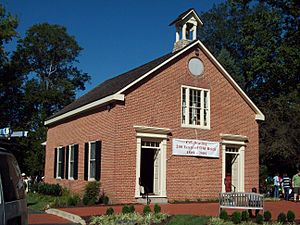Guilford, Maryland facts for kids
Quick facts for kids
Guilford, Maryland
|
|
|---|---|

Christ Church of Guilford, rebuilt in 1809
|
|
| Country | United States |
| State | Maryland |
| County | Howard |
| CDPs | Jessup, Columbia |
| Established | December 31, 1874 |
| Named for | Guilford Factory |
| Time zone | UTC-5 (Eastern) |
| • Summer (DST) | UTC-4 (EDT) |
| ZIP code |
20794, 21046
|
| Area code | 410, 443, and 667 |
Guilford is a community in Howard County, Maryland. It is an "unincorporated community", meaning it doesn't have its own local government like a town or city. Guilford was named after the old Guilford Mill. It is located near Kings Contrivance and Columbia.
For official statistics, Guilford is split between the areas of Savage and Columbia.
Contents
A Look Back at Guilford's History
The area around Guilford was settled long before it got its current name.
Early Days and the Church
In 1711, a small chapel called the Log Chapel of Ease was built. Today, it is known as Christ Church Guilford. This church is located north of Guilford. It was added to the National Register of Historic Places in 1978, which means it's an important historical site.
The Guilford Mill Story
The Guilford Mill, later called Gary Mill, was located on the Little Patuxent River. A mill was likely working here as early as 1743. By 1761, a mill was definitely in operation. Early owners built a "joint mill" and a Gristmill to grind grain.
By 1792, the site had a gristmill, a sawmill, a blacksmith shop, and a stable. Later, in 1881, the mill was a cotton factory with 50 looms. Sadly, a fire destroyed the mill on August 15, 1890.
Digging into the Quarry
Around 1834, a granite quarry started operating in Guilford. A quarry is a place where stone is dug out of the ground. The stone from this quarry is known as Guilford Quartz Monzonite.
From 1863 to 1890, the quarries were mostly quiet. When they started up again, they offered good jobs for African American workers. These workers were not allowed to work in the nearby town of Savage. Many workers stayed in a hotel and bought supplies from a company store.
In 1901, the Maryland Granite Company bought the quarry. A special train track was built in 1902 to connect Savage and Guilford. The steel bridge built that year is still there today. By 1905, Guilford Road was paved with a material called macadam, making it easier to transport heavy loads.
By 1908, the main quarry was 100 feet deep. It produced stone for monuments and buildings. Another smaller quarry also operated nearby.
Schools and Community Life
On December 31, 1874, the Guilford Post Office opened. It stayed open until June 30, 1920. In 1876, the Guilford School opened. A separate school for African American children, the Guilford Colored School, also opened.
The First Baptist Church of Guilford was started by Reverend Willis Carter in a tenant house. It has grown and moved into its fourth new building since then.
In 1954, a new 11-room Guilford Colored School was built. It is still operating today as Howard County's oldest formerly segregated school.
Changes Over Time
From 1963 to 1966, a company called Rouse Company bought many farms in Howard County. The land around Guilford was bought for new developments.
Guilford Today
Today, Guilford Road stretches through parts of Columbia, Savage, and Annapolis Junction. It crosses major highways like Route 29, Route 32, I-95, and Route 295. This means the road has a mix of old parts and newly built sections.
Many older communities like Simpsonville, Waterloo, Magnolia, and Pierceland have become part of larger areas. Some large farms in the Guilford area, like Overlook Farm and Fairlands, are still well-preserved. However, a large farm called Wincopia Farms was sold for development. Now, 220 new homes are being built on that land.
Education
The Guilford area has one public school, Guilford Elementary School. It is located on Oakland Mills Road in Columbia. There are plans for a new elementary school to be built near the Savage Stone Quarry. In 2023, the new Guilford Park High School opened on land next to the Savage Stone Quarry.



